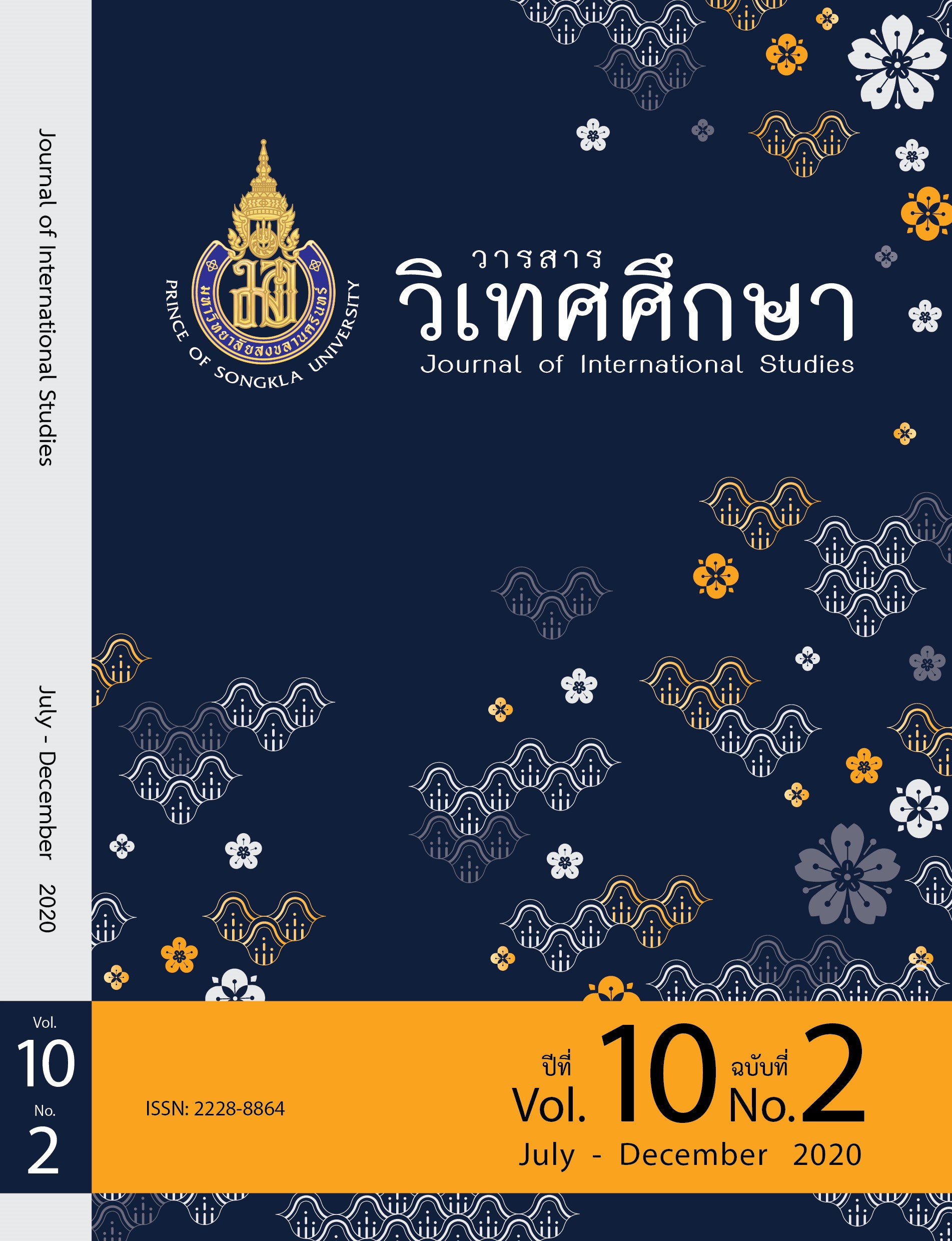แรงจูงใจที่มีอิทธิพลต่อพฤติกรรมการบริโภคอาหารท้องถิ่นริมทางในจังหวัดภูเก็ต
Main Article Content
บทคัดย่อ
การศึกษาครั้งนี้มีวัตถุประสงค์ เพื่อตรวจสอบแรงจูงใจที่มีอิทธิพลต่อความพึงพอใจและความภักดีของการบริโภคอาหารท้องถิ่นริมทางในจังหวัดภูเก็ต และวิเคราะห์ความพึงพอใจที่เป็นตัวแปรส่งผ่านระหว่างอิทธิพลของแรงจูงใจต่อความภักดีลูกค้าของการบริโภคอาหารท้องถิ่นริมทางในจังหวัดภูเก็ต การศึกษาได้เก็บรวบรวมข้อมูลด้วยแบบสอบถามจากนักท่องเที่ยวชาวไทยในจังหวัดภูเก็ต จำนวน 384 ชุด แล้ววิเคราะห์ด้วยวิธีโมเดลสมการโครงสร้าง ผลการศึกษาพบว่า ความต้องการส่วนบุคคล คุณลักษณะทางประสาทสัมผัส และความหลากหลายของอาหารมีอิทธิพลทางตรงต่อความพึงพอใจ นอกจากนั้นความหลากหลายของอาหาร และราคามีอิทธิพลทางตรงต่อความภักดีลูกค้า ส่วนผลการทดสอบตัวแปรส่งผ่านของความพึงพอใจ ชี้ให้เห็นว่าความพึงพอใจเป็นตัวแปรส่งผ่านระหว่างอิทธิพลของความต้องการส่วนบุคคล คุณลักษณะทางประสาทสัมผัส และความหลากหลายของอาหารต่อความภักดีลูกค้า
Article Details
ข้อความและความคิดเห็นที่แสดงในบทความ เป็นแนวคิดของผู้เขียน มิใช่ความรับผิดชอบของกองบรรณาธิการ และคณะผู้จัดทำแต่อย่างใด
บทความ ข้อมูล เนื้อหา รูปภาพ ฯลฯ ที่ได้รับการตีพิมพ์ในวารสารวิเทศศึกษา ถือเป็นลิขสิทธิ์ของวารสารวิเทศศึกษา หากบุคคลหรือหน่วยงานใดต้องการนำทั้งหมดหรือส่วนหนึ่งส่วนใดไปเผยแพร่ต่อหรือเพื่อกระทำการใด ๆ จะต้องได้รับอนุญาตเป็นลายลักษณ์อักษรจากวารสารวิเทศศึกษา ก่อนเท่านั้น
เอกสารอ้างอิง
การท่องเที่ยวแห่งประเทศไทย. (2560). Go local. สืบค้นเมื่อ 17 พฤษภาคม 2561, จาก
https://thai.tourismthailand.org/
การท่องเที่ยวแห่งประเทศไทย. (2560). Food Tourism 2.0.สืบค้นเมื่อ 17 พฤษภาคม 2561, จาก
http://etatjournal.com/web/menu-read-tat/menu-2017/92-cate-2017-jan-mar/757-12017-food-tourism2.
ชัยนันต์ ไชยเสน. (2562). แนวทางการเพิ่มขีดความสามารถและนวัตกรรมการบริการธุรกิจร้านอาหารยุค 4.0 เพื่อส่งเสริมและพัฒนาจังหวัดภูเก็ตเป็นเมืองสร้างสรรค์ด้านอาหาร. วารสารวิทยาลัยดุสิตธานี, 13(3), 491- 504.
ณัฐริดา มงคลคีรี และเจริญชัย เอกมาไพศาล. (2561) การศึกษาปัจจัยผลักดันและดึงดูดที่มีอิทธิพลต่อพฤติกรรมการบริโภค อาหารริมทางของนักท่องเที่ยวไทย กรณีศึกษา ตลาดโต้รุ่งหัวหิน จังหวัดประจวบคีรีขันธ์. BU Academic Review, 17(1), 18-32.
ธนวัต คองประเสริฐ, สมชนก ภาสกรจรัส, และ พันธุมดี เกตะวันดี. (2557). ปัจจัยที่มีอิทธิพลต่อประเภทนักท่องเที่ยวญี่ปุ่นในจังหวัดเชียงใหม่. วารสารวิทยาการจัดการ, 31(2), 1-33.
นิมิต ซุ้นสั้น. (2562). การวิเคราะห์แรงจูงใจของนักท่องเที่ยวชาวไทยที่เดินทางมาถนนวัฒนธรรม: กรณีศึกษาถนนวัฒนธรรมหลาดใหญ่ จังหวัดภูเก็ต. วารสารวิชาการมหาวิทยาลัยหอการค้าไทย (มนุษยศาสตร์และสังคมศาสตร์), 39(2), 16-31.
พิชญา แสงธูป และเจริญชัย เอกมาไพศาล. (2561). การศึกษาปัจจัยผลักดันและปัจจัยดึงดูดที่มีอิทธิพลต่อการบริโภคอาหารริมทางของผู้บริโภคชาวไทย: กรณีศึกษา ร้านอาหารริมทาง ย่านถนนเยาวราช กรุงเทพมหานคร. จุฬาลงกรณ์ธุรกิจปริทัศน์, 40(156), 103-145.
พิมพ์ระวี โรจน์รุ่งสัตย์. (2561). การพัฒนารูปแบบการจัดการภาพลักษณ์อาหารท้องถิ่นเพื่อเสริมสร้างความจงรักภักดีของนักท่องเที่ยวในจังหวัดเพชรบุรี. วารสารวิชาการการท่องเที่ยวไทยนานาชาติ, 14(1), 152-167.
โอปอล์ สุวรรณเมฆ และอภิวรรตน์ กรมเมือง. (2562). ปัจจัยที่มีผลต่อความพึงพอใจในการบริโภคอาหารริมบาทวิถีในเขตกรุงเทพมหานคร. วารสารบริหารธุรกิจศรีนครินทรวิโรฒ, 10(2), 144-155.
Bagozzi, R. P., & Yi, Y. (1988). On the evaluation of structural equation models. Journal of the Academy of Marketing Science, 16(1), 74-94.
Caber, M., & Albayrak, T. (2016). Push or pull? Identifying rock climbing tourists’ motivations. Tourism Management, 55, 74-84.
Chang, R. C. Y., Kivela, J., & Mak, A. H. N. (2011). Attributes that influence the evaluation of travel dining experience: When East meets West. Tourism Management, 32(2), 307–316.
Crompton, J. L. (1979). Motivations for pleasure vacation. Annals of Tourism Research, 6(4), 408-424.
Dann, G. M. (1977). Anomie, ego-enhancement and tourism. Annals of Tourism Research, 4(4), 184-194.
Dimitrovski, D., & Crespi-Vallbona, M. (2017). Role of food neophilia in food market tourists’ motivational construct: The case of La Boqueria in Barcelona, Spain. Journal of Travel & Tourism Marketing, 34(4), 475–487
Evanschitzky, H., Ramaseshan, B., Woisetschläger, D. M., Richelsen, V., Blut, M., & Backhaus, C. (2012). Consequences of customer loyalty to the loyalty program and to the company. Journal of the Academy of Marketing Science, 40(5), 625-638.
Fornell, C., & Larcker, D. F. (1981). Eveluating structural equation models with unobservable variables and measure. Journal of marketing research, 18, 39-50.
Goeldner, C. R. & Ritchie, J. R. (2012). Tourism: Principles, practices, philosophies (12th ed.). Toronto: Wiley.
Hair, J. F., Anderson, B. W., Babin, B. J., & Anderson, R. E. (2010). Multivariate data analysis with reading (Vol. 4th). New Jersey: Prentice-Hall.
Hulland, J. (1999). Use of partial least squares (PLS) in strategic management research: A review of four recent studies. Strategic Management Journal, 20(2), 195-204.
Jeaheng, Y., Al-Ansi, A., & Han, H. (2020). Impacts of Halal-friendly services, facilities, and food and Beverages on Muslim travelers’ perceptions of service quality attributes, perceived price, satisfaction, trust, and loyalty. Journal of Hospitality Marketing & Management, 1-25.
Kandampully, J., Zhang, T. C., & Bilgihan, A. (2015). Customer loyalty: a review and future directions with a special focus on the hospitality industry. International Journal of Contemporary Hospitality Management.
Kim, Y. G., Eves, A., & Scarles, C. (2013). Empirical verification of a conceptual model of local food consumption at a tourist destination. International Journal of Hospitality Management, 33(1), 484–489.
Khongtong, J., Ab Karim, S., Othman, M., & Bolong, J. (2014). Consumption pattern and consumers' opinion toward street food in Nakhon Si Thammarat province, Thailand. International Food Research Journal, 21(1), 125-130.
Lin, C. H. (2014). Effects of cuisine experience, psychological well-being, and self-health perception on the revisit intention of hot springs tourists. Journal of Hospitality & Tourism Research, 38(2), 243-265.
Mak, A. H. N., Lumbers, M., Eves, A., & Chang, R. C. Y. (2012). Factors influencing tourist food consumption. International Journal of Hospitality Management, 31(3), 928–936.
Moutinho, L. (Ed.). (2000). Strategic management in tourism, New York, NY: CABI Publishing.
Nunnally, J. C. (1978). Psychomtietrictheory (Vol. 2nd). New York: McGraw-Hill.
Park, S. H., Lee, C. K., & Miller, J. C. (2015). A comparative study of the motivations, activities, overall satisfaction, and post-trip behaviors of international tourists in Macau: Mainland Chinese, Hongkongese, Taiwanese, and Westerners. Asia Pacific Journal of Tourism Research, 20(10), 1174-1193.
Prayag, G., Hassibi, S., & Nunkoo, R. (2019). A systematic review of consumer satisfaction studies in hospitality journals: conceptual development, research approaches and future prospects. Journal of Hospitality Marketing & Management, 28(1), 51-80.
So, K. K. F., King, C., Sparks, B. A. & Wang, Y. (2013). The influence of customer brand identification on hotel brand evaluation and loyalty. International Journal of Hospitality Management, 34, 31-41.
Tenenhaus, M., Vinzi, V. E., Chatelin, Y.-M., & Lauro, C. (2005). PLS path modeling. Computational Statistics & Data Analysis, 48(1), 159-205.
Tolman, E.C. (1959). Principles of purposive behavior. In S. Koch, Psychology: A study of a science: Vol. 2 (pp. 92-157). New York: McGraw-Hill.
Yeoman, I., & McMahon-Beatte, U. (2016). The future of food tourism. Journal of Tourism Futures, 2(1), 95-98.


